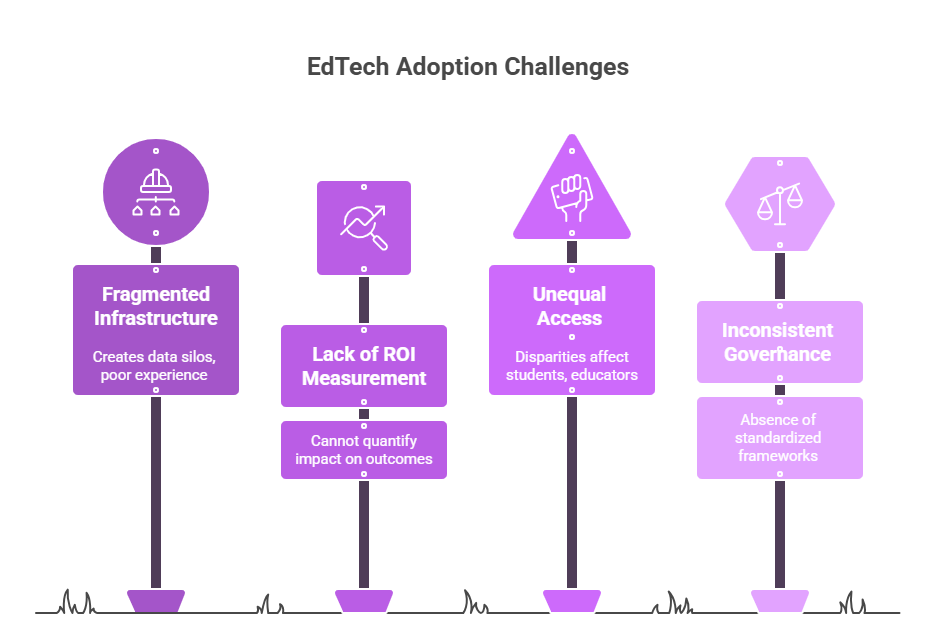Education worldwide has entered a defining phase of digital acceleration. From cloud-based learning management systems (LMS) and AI-enabled content platforms to virtual classrooms and adaptive assessments, technology now underpins how institutions deliver learning experiences.
Yet, as digital adoption expands, the conversation has shifted from “Are we digital?” to “How mature is our digital ecosystem?” Institutions are realizing that digital presence alone does not equal digital performance. True transformation depends on how effectively technology improves learning outcomes, operational efficiency, and student engagement.
This is where technology benchmarking becomes indispensable. By comparing infrastructure, learning tools, analytics capabilities, and engagement outcomes across peer institutions, benchmarking enables universities and education providers to quantify their digital learning maturity and identify strategic improvement areas.
The Challenge: Uneven Digital Learning Transformation
The education sector’s digital evolution has been both rapid and uneven. While some institutions have embraced technology to deliver fully integrated and adaptive learning ecosystems, others remain dependent on fragmented, outdated systems that limit accessibility and scalability.
This digital divide stems from several deep-rooted challenges that benchmarking can help quantify and resolve:

- Fragmented Technology Infrastructure: Many institutions deploy multiple learning management systems (LMS), virtual classroom tools, and content platforms without integration. This creates data silos, inconsistent user experiences, and limited performance visibility across departments.
- Lack of Measurable ROI from Digital Investments: Despite significant investment in edtech platforms, few institutions can quantify the impact on student learning outcomes, engagement, or faculty productivity. Benchmarking helps connect digital expenditure with tangible academic and operational gains.
- Unequal Access and Digital Literacy Gaps: Disparities in access to devices, internet connectivity, and technical support continue to affect students and educators, particularly in rural or underfunded institutions. Benchmarking exposes these inequities and helps build targeted improvement plans.
- Inconsistent Governance and Policy Alignment: The absence of standardized frameworks for data security, digital ethics, and compliance leads to inconsistent adoption across institutions. Benchmarking allows education leaders to measure how their governance models compare with global best practices.
As the digital learning landscape continues to evolve, institutions need a clear understanding of their digital maturity curve, where they currently stand, how they compare to global peers, and what steps will yield measurable transformation. This is where Nexdigm’s Digital Learning Benchmarking Framework provides strategic clarity and direction.
Nexdigm’s Digital Learning Benchmarking Framework
Digital transformation in education requires data-backed evaluation and structured comparison. Nexdigm’s Digital Learning Benchmarking Framework enables universities, schools, and edtech organizations to objectively measure their technology maturity, compare performance against peer institutions, and identify improvement areas that align with academic, operational, and student success goals.
Our approach combines competitive intelligence, institutional analytics, and digital capability benchmarking to help education leaders turn digital adoption into measurable impact.
Core Components of the Framework
- Digital Infrastructure and Platform Mapping: Nexdigm begins by analyzing the institution’s existing digital ecosystem, benchmarking scalability, uptime, integration, and accessibility across peer institutions.
- Learning Experience and Pedagogical Benchmarking: We assess how effectively institutions leverage AI-driven personalization, gamified content, and adaptive learning technologies to enhance engagement and retention. This ensures technology investments translate into stronger learning outcomes.
- Data and Analytics Capability Assessment: The framework evaluates how institutions use data to improve learning journeys, benchmarking these capabilities against global best practices.
- Governance, Compliance, and Security Alignment: Nexdigm benchmarks institutions on data protection, cybersecurity, accessibility standards (WCAG), and ethical AI usage, ensuring digital transformation aligns with governance and regulatory expectations.
- ROI and Institutional Performance Modelling: Beyond technology deployment, we measure the correlation between digital maturity and academic results, assessing how digital transformation influences student satisfaction, operational efficiency, and cost-effectiveness.
- Strategic Roadmap for Digital Learning Maturity: Insights from benchmarking are synthesized into a customized digital maturity roadmap, outlining short-term interventions, long-term transformation milestones, and measurable KPIs for sustained progress.
Through this structured approach, Nexdigm helps educational institutions evolve from adoption to optimization, ensuring that every technology initiative strengthens institutional capability, inclusivity, and competitiveness in an increasingly digital-first education landscape.
To take the next step, simply visit our Request a Consultation page and share your requirements with us.
Harsh Mittal
+91-8422857704

